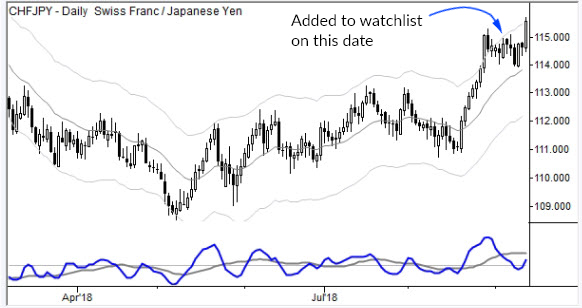Stalking a trade--patience
So many of us get into trading for action and excitement. (That was one of the things that drew me to trading, years ago.) But what it takes to be successful is often the exact opposite--the patience and willingness to do nothing at all, until the time is right. We might think of this as stalking a trade, like a hunter carefully tracks prey, and then waits to strike. Act too early, and you go home hungry.
Here's a solid example from today's market. Take a look at this trade in the CHFJPY:

Now, that's a great trade. Today, we just entered the breakout of that nice daily bull flag, and, at the time I screencapped the chart, we're up like 0.6R on the trade. Good entry, clean followthrough--exactly what you want. But how did we get there?
Waiting is hard
This trade follows on some other CHF trades I've made this year, so the first thing is that I'm very in touch with the CHF as a pair and in various crosses. I'm assessing each of those daily for best opportunity and cleanest setup. On 9/5/18, I put this trade on our watchlist, with a trigger price above the consolidation, and then we wait...

What do you do while you wait for a trade to trigger? Nothing at all. I think that's an important lesson, no matter what your timeframe is. An intraday trader might be tempted to move orders around or to "mess" with the trade in different ways: maybe you enter a little bit, maybe you keep walking the trigger down, maybe you try scalping some while you wait. A trader on the daily chart might get very anxious, enter early, try to use hourly charts to trigger entries, etc. All of this usually adds up to small (or not so small) losses.
While you're waiting for a trade to trigger, you do nothing. Re-assess the trade on the appropriate schedule. If you're a daily trader, look at the end of each day and ask if the setup is still valid, if you should move your trigger (answer is usually no), and where your initial stop will be located. This is part of the work of daily swing trading, and it only takes a few minutes. Don't try to create more work or activity for yourself!
This lesson took me a very long to learn. Even after I'd achieved a fair degree of profitability, I still felt an urge to do something--I felt that, if I wasn't doing anything, I was being lazy, or that I wasn't working hard enough. But, in trading, doing nothing is so often the right thing. (Of course, we can oversimplify this; when it's time to act, act we must.)
Lessons
So what are the lessons here? I think there are a few:
- First, another reminder of the power of the simple pullback trade. This is the same "boring" structure on the daily chart that many people are tempted to dismiss. But you can build an entire trading program around this one, simple pattern! This is powerful stuff.
- Second, the idea that we are often rewarded for waiting patiently. Avoid the urge to do something. Don't feel you are wasting time when you are doing nothing, if you are working correct entries in the markets and timeframes you follow.
Want to see trades like this before they happen?
I share trades like this for my clients in both MarketLife and Talon. MarketLife is strongly education-focused, and features daily video content of my analysis of both stock and currency markets. Talon is institutional research (which we've priced to be accessible to the individual trader), focusing on swing trades and longer-term perspectives in global stocks, currencies, and futures markets. I've been writing this research daily for nearly 9 years, and have accumulated an outstanding track record. We'd love to have you check my companies out and see if they can help you in your own trading and investing!



